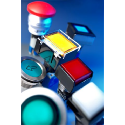Capacitors
Capacitors consist of two conductors (or plates) an insulator (dielectric) which are wired to two electrical connections on the outside called terminals. They gather and hold a charge in a way similar to batteries and can keep it even when the voltage is no longer applied. Adding energy to a capacitor is called charging and releasing it is called discharging. This release of energy can be done in a fraction of a second. The types of capacitor depend on its size, maximum voltage, leakage current, ESR (equivalent series resistance) and tolerance; they can be used in series or parallel. One type is the film capacitor which is used for low parasitic losses. Aluminium electrolytic and tantalum electrolytic capacitors are specifically designed for high voltages. Decoupling capacitors reduce the effect of noise caused by other circuit elements. Large supercapacitors can be used instead of batteries. Other kinds include variable capacitors, used as an alternative to resistors, and mica capacitors. Capacitors are energy-storing devices which are largely used in television, radios and electrical equipment. The burst of energy provided for the flash of a camera comes from a capacitor. They are also necessary for signal processing, power conditioning suppression and coupling, motor starters and pulse weapons.
-
Tennco Distribution Ltd
View company profileAt Tennco Distribution Limited, we are a progressive electromechanical component distributor. We are family owned and operate in niche markets concentrating on electronic and electrical components for the computing, networking, instrumentation, panel building, audio and circuit board assembly industries.
Backed by 30 years experience, at Tennco, we are committed to service and efficient components distribution coupled with ISO 9002 approval. We offer products at competitive prices with a fast friendly and efficient service.
-
JPR Electronics Ltd
View company profileEstablished for over 35 years JPR Electronics are an independent electronics distributor offering a wide range of components and assemblies, with a highly flexible approach to our customers needs.
- Prices are amongst the most competitive available in the UK
- All products supplied from stock. Schedules and call-offs are welcome.
- Our full range of products can be viewed on our website. Orders can be placed online or by phone, fax or email for same day despatch.
-
Analog Devices Ltd
View company profileAnalog Devices, Inc. operates at the centre of the modern digital economy, converting real-world phenomena into actionable insight with its comprehensive suite of analogue and mixed signal, power management, radio frequency (RF), and digital and sensor technologies. ADI serves 125,000 customers worldwide with more than 75,000 products in the industrial, communications, automotive, and consumer markets. ADI is headquartered in Wilmington, MA. Visit www.analog.com. Both Linear Technology and Maxim Integrated are now part of Analog Devices.
Analog Devices provide efficient solutions for power management and power conversion applications in the automotive, telecommunications, industrial, medical, computing, military and high-end consumer markets using high-performance analogue ICs. Our power ICs can provide unrivalled power densities and software design simulation tools to provide both fast and accurate power module and power supply designs.
Products for power management include: switching regulators, linear regulators (LDO), µModule regulators, PMIC & Multifunction, inductorless (charge pump) DC/DC converters, LED driver ICs, power control, battery management, current source, system supervisor, hot-swap controllers, monitor and control, energy harvesting, super capacitor chargers and power management evaluation kits.
-
AV Industrial Products Ltd
View company profileThe company is based in Leicester (central England) with easy access to all motorway networks. It was founded approximately 20 years ago with links with the anti-vibration mounting industry for over 40 years, so is well positioned to offer expert advice and specialist knowledge of all vibration control products and applications.
As well as offering an extremely wide range of standard products for next day delivery, We also offer custom made products in a wide range of elastomers including natural and synthetic rubber bonded to such materials as steel, stainless steel, aluminium and various plastics.
- Decades of experience
- Unbeatable Value
- High Quality product compliance
- Product testing - Physical and chemical material analysis
- Product design criteria




